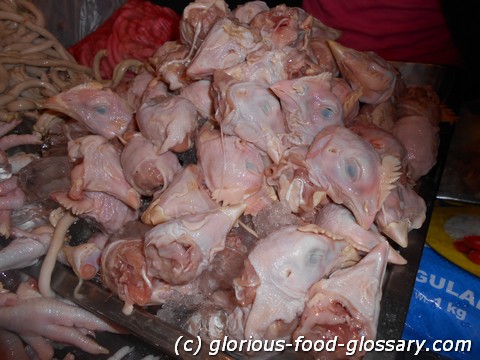Deutsch: Hühnerkopf / Español: Cabeza de pollo / Português: Cabeça de frango / Français: Tête de poulet / Italiano: Testa di pollo
Ulo ng Manok refers to the head of a chicken, a part often used in various cuisines around the world, including Filipino cuisine. In many cultures, the chicken head is not commonly consumed or is considered a byproduct; however, in Filipino and other Asian cuisines, it is utilized in various dishes, showcasing a philosophy of minimizing waste and appreciating the whole animal.
Description
In the context of Filipino food, Ulo ng Manok is not just a testament to the culinary creativity of the culture but also to its sustainable approach to food consumption. While not as commonly served as other parts of the chicken, the head is known for its unique texture and flavor. It can be prepared in various ways, including grilling, boiling in soups, and as part of traditional stews. This utilization reflects the Filipino tradition of valuing every part of an animal, ensuring that nothing goes to waste.
The consumption of Ulo ng Manok can also be seen in street food settings, where it is often grilled on skewers (similar to isaw, or chicken intestines) and served with a dipping sauce made of vinegar, chili, and spices. This dish highlights the versatility of Filipino street food and its ability to turn less commonly used ingredients into delicious snacks.
Application Areas
Ulo ng Manok finds its place predominantly in traditional Filipino gatherings and local eateries, especially those that specialize in native cuisine. It's also a common sight in street food markets, where adventurous eaters seek out unique and authentic experiences. Beyond the Philippines, restaurants serving authentic Filipino and Asian fusion cuisine might offer dishes featuring chicken heads, catering to both expatriate communities and curious food enthusiasts looking to explore traditional culinary practices.
Well-Known Examples
While specific establishments known for Ulo ng Manok might not be as widely recognized internationally as those for other dishes, in the Philippines, local markets, street food stalls, and traditional eateries often feature this item. It's more about the cultural experience and traditional cooking methods that make Ulo ng Manok a noteworthy example of Filipino culinary heritage rather than specific restaurants or chefs.
Treatment and Risks
Consuming Ulo ng Manok, like any poultry product, carries risks if not prepared correctly. Proper handling and thorough cooking are essential to eliminate potential pathogens like Salmonella. It's also important for consumers to be aware of the texture and small bones when eating chicken heads to avoid choking hazards. From a nutritional perspective, while the chicken head may not provide as much meat as other parts, it offers a unique taste and experience for those willing to explore traditional Filipino delicacies.
Recipes
A simple way to prepare Ulo ng Manok is by grilling:
Grilled Ulo ng Manok Recipe:
Ingredients:
- Chicken heads, cleaned and washed
- Salt and pepper to taste
- Soy sauce
- Calamansi juice (or lemon juice)
- Minced garlic
- Chili peppers (optional)
Instructions:
- Marinate the chicken heads in a mixture of soy sauce, calamansi juice, minced garlic, salt, and pepper. Add chili peppers if you prefer a spicy taste. Let it marinate for at least 1 hour.
- Preheat the grill to medium-high heat.
- Grill the chicken heads, turning occasionally, until fully cooked and slightly charred on the outside, about 10-15 minutes.
- Serve hot with a dipping sauce of vinegar, soy sauce, chopped onions, and chili peppers.
Similar Terms or Synonyms
- Isaw: While technically referring to chicken intestines, it's often mentioned in conjunction with Ulo ng Manok in the context of Filipino street food.
- Chicken offal: A broader term that includes various chicken by-products, including the head.
Summary
Ulo ng Manok, or chicken head, is a less common but culturally significant part of Filipino cuisine, demonstrating the culture's sustainability and resourcefulness. It's prepared in various ways, from being grilled on skewers as street food to being included in traditional dishes. While it might not be for everyone, Ulo ng Manok offers a unique taste experience and insight into the comprehensive use of ingredients in Filipino cooking.
--


